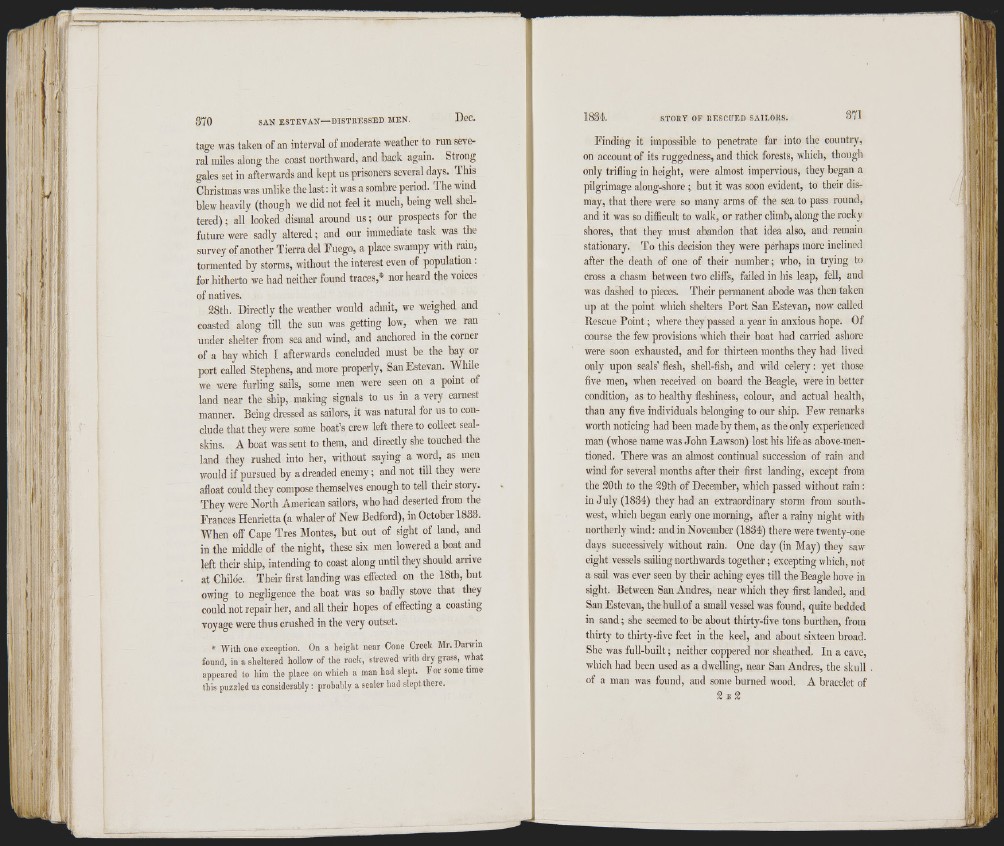
i
370 SAN ESTEVAN— DISTRESSED MEN. Dec.
tage was taken of an interval of moderate weather to run several
miles along the coast northward, and back again. Strong
gales set in afterwards and kept us prisoners several days. This
Christmas was unlike the last: it was a sombre period. The wind
blew heavily (though we did not feel it much, being well sheltered)
; all looked dismal around u s ; our prospects for the
future were sadly altered ; and our immediate task was the
survey of another Tierra del Fuego, a place swampy with rain,
tormented by storms, without the interest even of population :
for hitherto we had neither found traces,* nor heard the voices
of natives.
28th. Directly the weather would admit, we weighed and
coasted along till the sun was getting low, when we ran
under shelter from sea and wind, and anchored in the corner
of a bay which I afterwards concluded must be the bay or
port called Stephens, and more properly, San Fstevan. While
we were furling sails, some men were seen on a point of
land near the ship, making signals to us in a very earnest
manner. Being dressed as sailors, it was natural for us to conclude
that they were some boat’s crew left there to collect sealskins.
A boat was sent to them, and directly she touched the
land they rushed into her, without saying a word, as men
would if pursued by a dreaded enemy; and not till they were
afloat could they compose themselves enough to tell their story.
They were North American sailors, who had deserted from the
Frances Henrietta (a whaler of New Bedford), in October 1833.
When off Cape Tres Montes, but out of sight of land, and
in the middle of the night, these six men lowered a boat and
left their ship, intending to coast along until they should arrive
at Childe. Their first landing was effected on the 18th, but
owing to negligence the boat was so badly stove that they
could not repair her, and all their hopes of effecting a coasting
voyage were thus crushed in the very outset.
* With one exception. On a height near Cone Creek Mr. Darwm
found, in a sheltered hollow of the rock, strewed with dry grass, what
appeared to him the place on which a man had slept. For some time
this puzzled us considerably; probably a sealer bad slept there.
1834. STORY OF RESCUED SAILORS. 371
Finding it impossible to penetrate far into the country,
on account of its ruggedness, and thick forests, which, though
only trifling in height, were almost impervious, they began a
pilgrimage along-shore ; but it was soon evident, to their dismay,
that there were so many arms of the sea to pass round,
and it was so difficult to walk, or rather climb, along the rocky
shores, that they must abandon that idea also, and remain
stationary. To this decision they were perhaps more inclined
after the death of one of their number; who, in trying to
cross a chasm between two cliffs, failed in his leap, fell, and
was dashed to pieces. Their permanent abode was then taken
up at the point wliich shelters Port San Fstevan, now called
Rescue Point; where they passed a year in anxious hope. Of
course the few provisions which their boat had carried ashore
were soon exhausted, and for thirteen months they had lived
only upon seals’ flesh, shell-fish, and wild celery : yet those
five men, when received on board the Beagle, were in better
condition, as to healthy fleshiness, colour, and actual health,
than any five individuals belonging to our ship. Few remarks
worth noticing had been madehy them, as the only experienced
man (whose name was John Lawson) lost his life as above-mentioned.
There was an almost continual succession of rain and
wind for several months after their first landing, except from
the 20th to the 29th of December, which passed without rain:
in July (1834) they had an extraordinary storm from southwest,
which began early one morning, after a rainy night with
northerly wind: and in November (1834) there were twenty-one
days successively without rain. One day (in May) they saw
eight vessels sailing northwards together; excepting which, not
a sail was ever seen by their aching eyes till the Beagle hove in
sight. Between San Andres, near which they first landed, and
San Fstevan, the hull of a small vessel was found, quite bedded
in sand; she seemed to be about thirty-five tons burthen, from
thirty to thirty-five feet in the keel, and about sixteen broad.
She was full-built; neither coppered nor sheathed. In a cave,
which had been used as a dwelling, near San Andres, the skull .
of a man was found, and some burned wood. A bracelet of
2 I! 2
i r
,